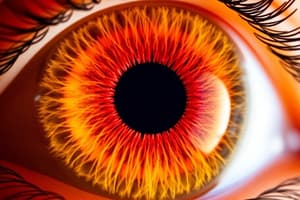Podcast
Questions and Answers
What did Darwin express about the evolution of the eye in relation to natural selection?
What did Darwin express about the evolution of the eye in relation to natural selection?
- He believed that complex organs like the eye were beyond reach of evolution.
- He found it plausible that natural selection could produce the eye.
- He thought the human eye could not have evolved from simpler forms.
- He considered the idea of natural selection producing the eye to be absurd. (correct)
Which of the following best describes the presence of eyes in the common ancestor of all animals?
Which of the following best describes the presence of eyes in the common ancestor of all animals?
- Eyes were absent in the common ancestor of all animals. (correct)
- Sponges were known to possess primitive eyes in their lineage.
- The common ancestor of all animals had various types of eyes.
- Eyes were common in the common ancestor of all animals.
What feature do all animal eyes use to capture light?
What feature do all animal eyes use to capture light?
- Lens structures
- Crystallins
- Photoreceptors (correct)
- Pupil adjustments
How do the eyes of octopuses and squids differ from human eyes?
How do the eyes of octopuses and squids differ from human eyes?
Which of the following correctly categorizes the clade that contains animals with eyes?
Which of the following correctly categorizes the clade that contains animals with eyes?
What kind of eyes do scallops possess?
What kind of eyes do scallops possess?
Which type of animal is stated to lack eyes according to the evolutionary lineage?
Which type of animal is stated to lack eyes according to the evolutionary lineage?
What is a key difference in the photoreceptors of different animal groups?
What is a key difference in the photoreceptors of different animal groups?
What is the primary role of opsins in the eye?
What is the primary role of opsins in the eye?
Which type of opsin is found in all vertebrates?
Which type of opsin is found in all vertebrates?
What distinguishes r-opsins from c-opsins in terms of storage?
What distinguishes r-opsins from c-opsins in terms of storage?
Which of the following animal lineages does not utilize c-opsins for image capture?
Which of the following animal lineages does not utilize c-opsins for image capture?
What was the conclusion made by scientists regarding the evolution of eyes in different animal lineages?
What was the conclusion made by scientists regarding the evolution of eyes in different animal lineages?
In humans, what is the role of r-opsins?
In humans, what is the role of r-opsins?
What does the presence of c-opsins in invertebrates like ragworms suggest?
What does the presence of c-opsins in invertebrates like ragworms suggest?
Which statement is true regarding the opsins found in different animal groups?
Which statement is true regarding the opsins found in different animal groups?
Flashcards are hidden until you start studying
Study Notes
Complex Adaptations: The Evolution of Eyes
-
Darwin was amazed by the complexity of the human eye, considering it a prime example of natural selection.
-
The eye's evolution can be traced back to the earliest derived lineages of living animals, the sponges and placozoans, which lack eyes.
-
Eyes evolved in a clade of more derived animals known as eumetazoans.
Eye Types and Diversity
-
All animal eyes capture light with cells called photoreceptors but vary greatly in shape and structure, from the camera-like eyes of humans and octopuses to the simple light-sensitive spots of flatworms.
-
The photoreceptors of octopuses and squids point outward from the retina, while human photoreceptors point inwards.
The Role of Opsins
-
Light triggers reactions in opsin molecules located on the surface of photoreceptor cells, initiating electrical signals sent to the brain.
-
All vertebrates utilize c-opsins, which are found in stacks of disks within the cilia of the retina.
-
Invertebrates, including insects, octopuses, and scallops, use r-opsins, which are stored in membrane foldings of their photoreceptors.
-
Both c-opsins and r-opsins evolved in separate lineages, suggesting independent evolution of image-capturing organs.
Convergent Evolution: Similarities and Differences
-
Humans produce both c-opsins and r-opsins, but r-opsins play a role in image processing rather than light capture.
-
Invertebrates also have c-opsins, as found in ragworms.
-
These discoveries demonstrate that complex organs like the eye can evolve through convergence, with different evolutionary paths leading to similar structures and functions.
Studying That Suits You
Use AI to generate personalized quizzes and flashcards to suit your learning preferences.




